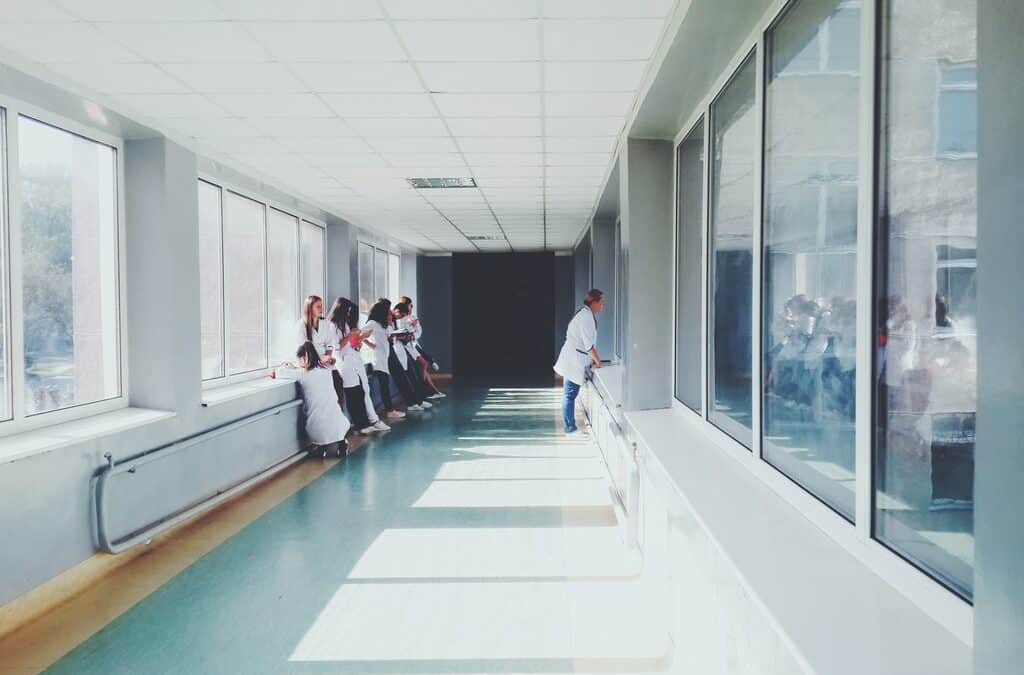The importance of hospitals being clean, well-maintained, and sterile in required areas cannot be overstated. A sanitary environment where patients can rest and recover without fear of picking up additional ailments is critical. With that said, there’s a lot that goes into cleaning a hospital properly, but any good environmental services team must start with the basics. The CDC has published the best practices for environmental cleaning in healthcare settings like hospitals that should guide cleaning procedures, but to help you get started, read on to learn how to clean a hospital.
Or, leave hospital cleaning to the best professionals in the industry. Contact us today at 360clean for a free estimate on cleaning for your hospital or facility.
The Benefits of Cleaning a Hospital Properly
The most obvious benefit of a thoroughly clean hospital is the limitation of the spread of pathogens and other illnesses. Determining the exact cleaning routines for patient care areas, including the methods and products used, as well as the appropriate frequency, depends on three main factors:
- The probability of contamination
- The potential for exposure
- The vulnerability of patients to infection
When hospitals are cleaned according to a schedule that has been created using this risk assessment guide, the health of everyone within is protected.
General Cleaning Techniques for Hospitals
When cleaning a hospital, cleaning procedures will vary depending on the type of area being tended to. For instance, a hospital’s cafeteria is cleaned differently than patient rooms and operating rooms! However, in every area, no matter the type, there is a general method that the CDC, OSHA, and other governing entities require.
High-Touch Surfaces
You’ll need to identify high-touch surfaces and items in each area before you begin. These areas should be attended to after low-touch surfaces have been cleaned. Common high-touch surfaces in hospitals include:
- IV poles
- Bed rails
- Door knobs
- Call lights
- Bedside tables
- Patient monitoring equipment
- Sink handles
- Bed rails
- Light switches
Low-touch areas include things like mirrors, wall art, walls, and windows.
Recommended Frequency for Cleaning Hospital Areas
Different areas of hospitals should be cleaned at various intervals as follows, according to the CDC:
- Examination/Consultation: At least twice daily
- Admission/Waiting: At least once daily
- Procedural/Minor Operative: Before and after every procedure and end of the day
The CDC recommends that any other high-touch surfaces be cleaned at least once daily, with low-touch surfaces being cleaned on a scheduled basis (daily, weekly, etc.) or whenever they are visibly dirty.
How to Clean Hospitals: An Overview
For all cleaning procedures, OSHA and the CDC require that the following strategies are always followed:
Visually Assess the Hospital Area
It is essential to assess the area before cleaning begins to see if you’ll need additional PPE or supplies. You need to also see if the patient’s status could hinder cleaning (or vice-versa) and if there are any obstacles or problems that need attention.
Start with the Cleanest and Move to the Dirtiest
Always begin with cleaner, low-touch surfaces before moving on to dirtier, often high-touch, areas. In doing so, you’ll avoid spreading dirt and germs. Take care of areas that the patient rests in, such as the bed and chair areas, before cleaning the bathroom or toilet areas. You should also clean all shared equipment and common surfaces first, then the items touched during patient care, and then objects directly touched by the patient.
Clean from the Top to the Bottom
Starting your cleaning from areas that are higher up and then working your way down prevents dirt and microorganisms from falling to places you’ve already cleaned. In addition, floors should always be the last thing you clean!
Always Work in a Methodical Manner
When you get into a cleaning routine and work in the same systematic manner, the chances of you accidentally missing something are greatly reduced. You can always work left to right or clockwise, for example. If you’re cleaning multiple patient rooms, always clean them the same way. For instance, start at the foot of the bed and work clockwise.
Best Practices for General Surface Cleaning
Never double-dip cleaning cloths into containers meant for storage solutions. In addition, those cleaning cloths, as well as mop heads, should never be shaken or left soaking in buckets.
Cleaning cloths should be changed between patient zones, whether they’re reusable or disposable. In addition, fresh cloths must be used at the start of each cleaning session and should be changed when they are no longer saturated with solution. For more information on cleaning body fluids, the CDC offers guidelines as well.
Leave the Cleaning to 360clean
At 360clean, we clean more than one million square feet of healthcare facility space every night, and our teams abide by industry best practices for cleaning in the healthcare niche. Let our professionals take care of your cleaning duties, and contact us today to receive a free quote!

